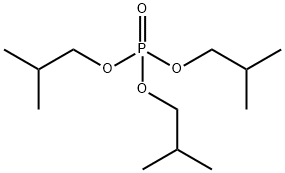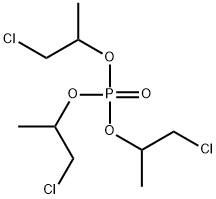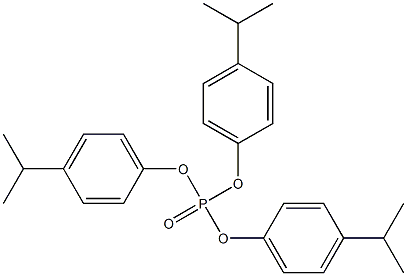Triisobutylphosphate , 98% , 126-71-6
Synonym(s):
Triisobutyl phosphate
CAS NO.:126-71-6
Empirical Formula: C12H27O4P
Molecular Weight: 266.31
MDL number: MFCD00039849
EINECS: 204-798-3
| Pack Size | Price | Stock | Quantity |
| 25ml | RMB55.20 | In Stock |
|
| 100ml | RMB207.20 | In Stock |
|
| 500ml | RMB719.20 | In Stock |
|
| others | Enquire |
PRODUCT Properties
| Melting point: | <-60°C |
| Boiling point: | ~205 °C(lit.) |
| Density | 0.965 g/mL at 20 °C(lit.) |
| vapor pressure | 0.002 hPa (20 °C) |
| refractive index | n |
| Flash point: | 150 °C |
| storage temp. | Store below +30°C. |
| solubility | 0.26g/l |
| form | Oil |
| color | Colourless |
| Water Solubility | 264mg/L at 25℃ |
| InChI | InChI=1S/C12H27O4P/c1-10(2)7-14-17(13,15-8-11(3)4)16-9-12(5)6/h10-12H,7-9H2,1-6H3 |
| InChIKey | HRKAMJBPFPHCSD-UHFFFAOYSA-N |
| SMILES | P(OCC(C)C)(OCC(C)C)(OCC(C)C)=O |
| LogP | 3.72 at 25℃ |
| CAS DataBase Reference | 126-71-6(CAS DataBase Reference) |
| EPA Substance Registry System | Triisobutyl phosphate (126-71-6) |
Description and Uses
Triisobutyl phosphate (TIBP) is a very strong polar solvent, sometimes known as Phosphoric acid triisobutyl ester. It is primarily used as an admixture for liquefying concrete, paper coating systems, and textile auxiliaries. It is mainly used as an antifoaming agent in various aqueous systems, where it can destroy foam and act as a foam inhibitor. TiBP is also used to introduce solutions for synthetic resins and natural rubber. In both ellulose-based plastics and synthetic resins, it is used as a flame-retarding plasticizer. TiBP is employed as a pasting agent for pigment pastes. Due to the limited influence of temperature on the viscosity of TiBP, it also serves as an important component in the manufacture of hydraulic fluids for aircraft. As a very strong wetting agent, TiBP is used in the textile industry and the field of adhesives.
Phosphate esters are used as flame retardants, plasticizers,
hydraulic fluids, solvents, extraction agents, antifoam agents,
Partition behavior in water, sediment, and soil
Phosphate ester flame retardants enter the environment from
industrial sources and disposal of consumer products containing
flame retardants. These anthropogenic compounds
have been detected in water, soil, and air owing to widespread
use following their fast emergence and popularization during
1970s. Occurrence of these phosphate ester flame retardants is
widespread in surface water and groundwater because of the
leaching of PVC plastics and polyurethane foams, effluent from
industrial sources, and spills of hydraulic fluids. This primary
contaminated water is then transported to a secondary source,
such as drinking water. Hydrolysis, although slow because of
poor solubility and pH dependence, is the most important
abiotic elimination process. In soil and sediment, phosphate
ester flame retardants are persistent because they have the
tendency to adsorb strongly. Volatilization and biodegradation
are potential elimination processes for phosphate esters
adsorbed to soil.
Environmental persistency (degradation/speciation)
These retardants can change chemical composition in the
environment. Generally, most phosphate esters are poorly
soluble in water and adsorb strongly to soils. These compounds
are considered emerging pollutants because of their prevalence
and persistence in the environment. Particulate-phase phosphate
esters are subject to wet and dry deposition, whereas
semi-volatile phosphate esters have the potential to hydrolyze
to diesters, monoesters, and phosphoric acid. There is no
information available that suggests that selected phosphate
ester flame retardants undergo transformation or degradation
in the atmosphere.
Long-range transport
This is highly dependent on the specific compound.
Bioaccumulation and biomagnification
Phosphate esters are subject to biodegradation in aquatic and
terrestrial environments.
Safety
| Symbol(GHS) |  GHS07 |
| Signal word | Warning |
| Hazard statements | H317 |
| Precautionary statements | P261-P272-P280-P302+P352-P333+P313-P362+P364 |
| Hazard Codes | Xi |
| Risk Statements | 43 |
| Safety Statements | 36/37 |
| WGK Germany | 1 |
| RTECS | TC9300000 |
| Autoignition Temperature | 430 °C DIN 51794 |
| HS Code | 2919 90 00 |
| Toxicity | LD50 orally in Rabbit: > 5000 mg/kg LD50 dermal Rabbit > 5000 mg/kg |






